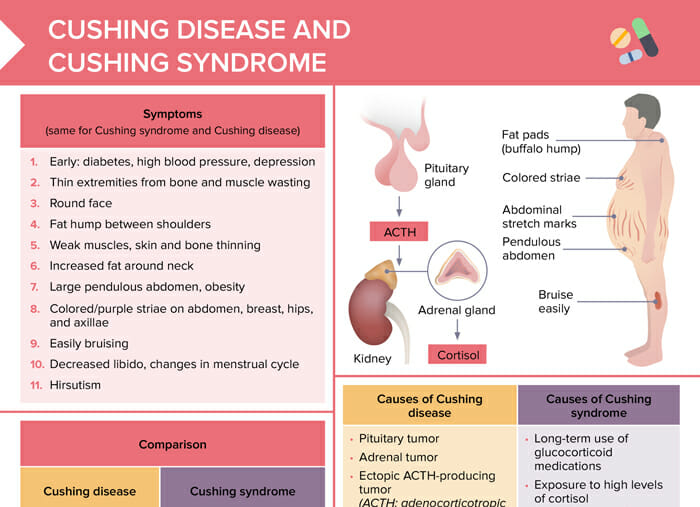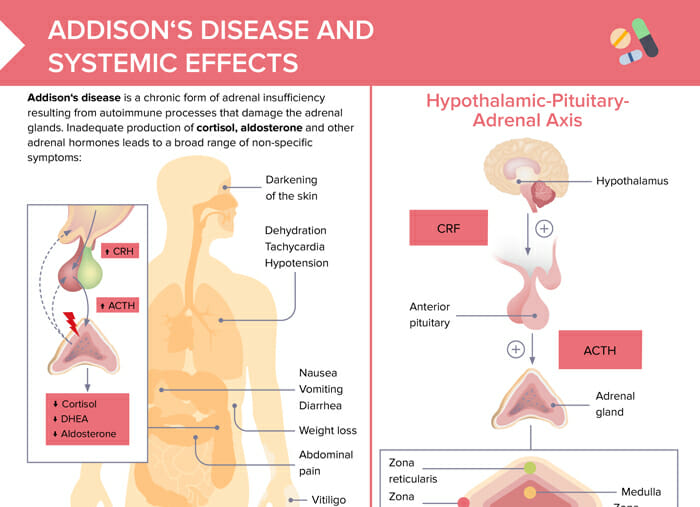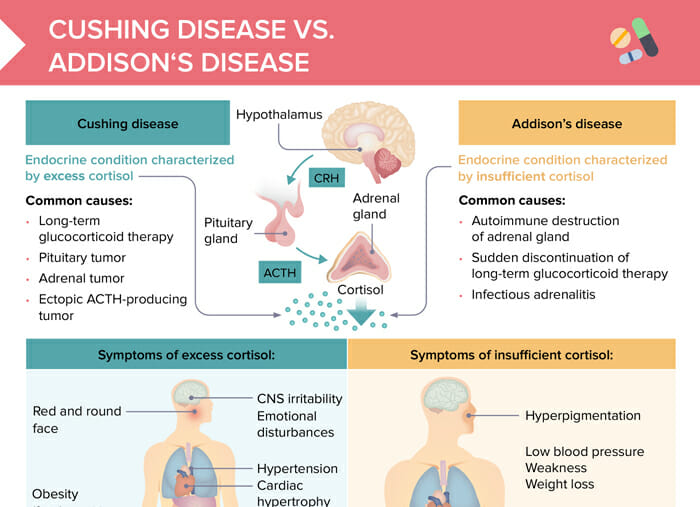What is cortisol?
Cortisol is a hormone produced by the adrenal glands that regulates various bodily functions, including metabolism, immune response, and stress response.
What is Cushing disease?
Cushing disease is an endocrine condition characterized by excess cortisol. Common causes include long-term glucocorticoid therapy, pituitary tumor, adrenal tumor, ectopic ACTH-producing tumor (adrenocorticotropic hormone), autoimmune destruction of adrenal gland, sudden discontinuation of long-term glucocorticoid therapy, and infectious adrenalitis.

Cushing disease and Cushing syndrome
Causes, symptoms, similarities and differences, diagnosis and treatment of Cushing Disease and Cushing Syndrome
What is Addison’s disease?
Addison’s disease is an endocrine condition characterized by insufficient cortisol. It is caused by damage to the hypothalamus, adrenal gland, or pituitary gland.

Addison’s Disease: Nursing Diagnosis
Explanation of chronic adrenal insufficiency caused by autoimmune destruction of adrenal glands
Cushing disease vs Addison’s disease: comparison table
Table: Cushing vs Addison’s
| Cushing disease | Addison’s disease | |
| Common causes | Long-term glucocorticoid therapy, pituitary tumor, adrenal tumor, ectopic ACTH-producing tumor | Autoimmune destruction of adrenal gland, sudden discontinuation of long-term glucocorticoid therapy, infectious adrenalitis |
| Symptoms | CNS irritability, emotional disturbances, obesity, red and round face, muscle wasting, hypertension, cardiac hypertrophy, hyperplasia, tumor, skin ulcers, osteoporosis, purple striae, amenorrhea and hirsutism in women, erectile dysfunction in men | Hyperpigmentation, weakness, weight loss, low blood pressure, nausea, vomiting, diarrhea, abdominal pain, vitiligo |
| Treatment | Surgical removal of tumor, reducing corticosteroid dose or changing medicine | Life-long exogenous corticosteroid replacement therapy |
Related videos
How to measure cortisol levels
Cortisol levels are primarily measured through blood tests, but they can also be checked using urine or saliva tests. Here’s the general process:
- Blood tests: Blood is drawn from a vein in the client’s arm. There are two types of cortisol blood tests: a morning (AM) test and an afternoon (PM) test, due to cortisol’s diurnal variation — it’s typically higher in the morning and lower in the afternoon.
- 24-hour urinary free cortisol test: The client collects all urine produced in a 24-hour period. This test can help avoid variations in cortisol levels throughout the day.
- Late-night salivary cortisol test: The client provides a saliva sample late at night, usually around midnight. Cortisol levels should normally be low at this time, so high levels could suggest a problem.
![Addisonian Crisis [+ Free Cheat Sheet] | Lecturio Nursing](https://cdn.lecturio.com/assets/Nursing_CS_Addisonian-Crisis.jpg)
